Extraction of Astaxanthin from Haematococcus pluvialis and Preparation of Astaxanthin Liposomes
Abstract
:1. Introduction
2. Results and Discussion
2.1. Standard Curve of Astaxanthin
2.2. Single-Factor Experimental Results
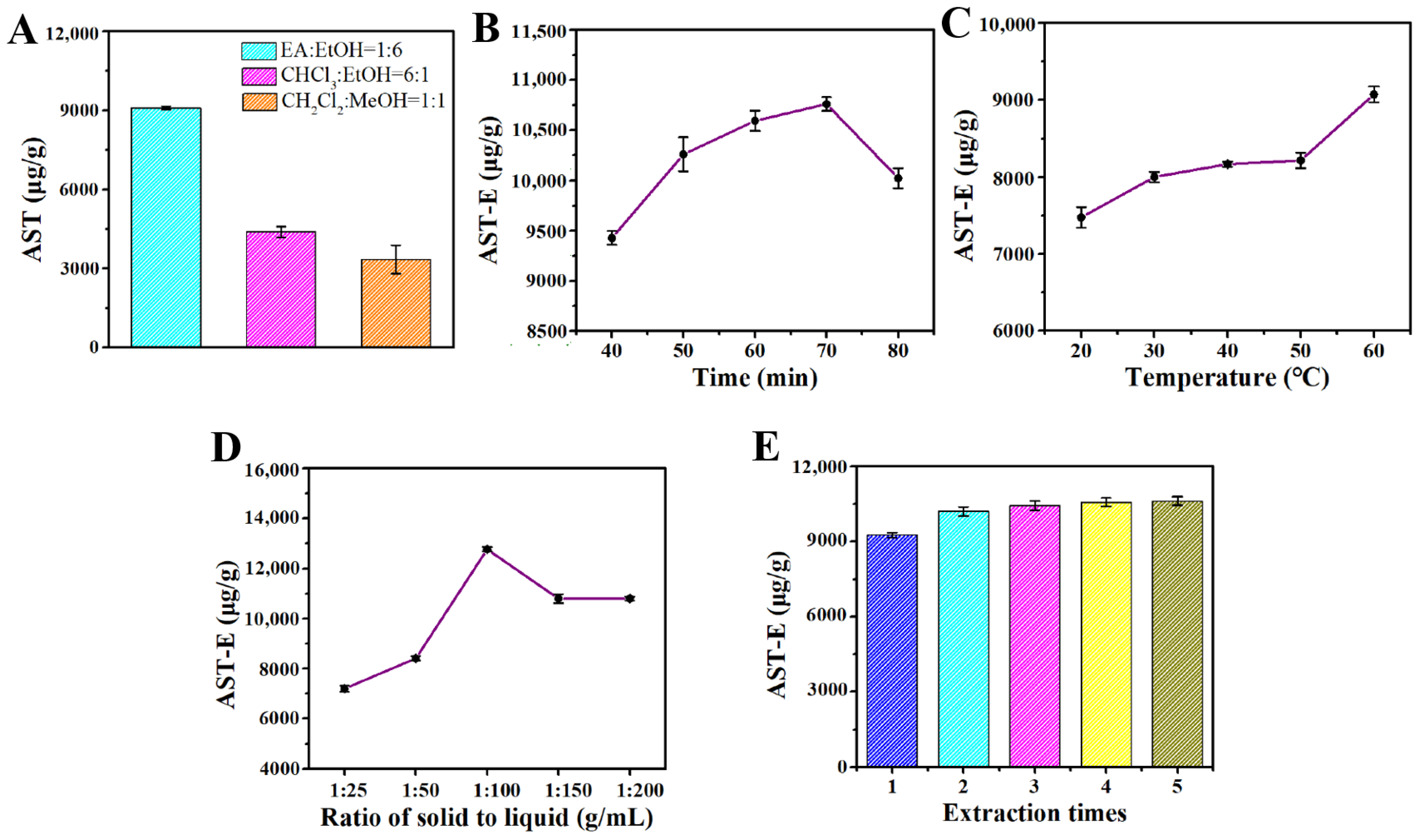
2.3. Characterization Results of Astaxanthin Liposomes
2.3.1. Morphology of Astaxanthin Liposomes
2.3.2. Particle Size Distribution and Zeta Potential of the Prepared Astaxanthin Liposomes
2.4. Encapsulation Efficacy and Loading Capacity of Astaxanthin Liposomes
2.5. Antioxidant Activity
2.6. Stability Results of Astaxanthin Liposomes
3. Experimental Method
3.1. Materials
3.2. Establishment of the Astaxanthin Standard Curve
3.3. Single-Factor Experiment
3.3.1. Extraction Solvent Screening
3.3.2. Extraction Time Screening
3.3.3. Extraction Temperature Screening
3.3.4. Extraction Solid–Liquid Ratio Screening
3.3.5. Extraction Time Screening
3.4. Preparation of Astaxanthin Liposomes
3.5. Characterization of Astaxanthin Liposomes
3.5.1. Morphology Characterization
3.5.2. Particle Size and Zeta Potential Characterization
3.5.3. Encapsulation Efficiency and Loading Capacity of Astaxanthin Liposomes
3.6. Antioxidant Activity (Measurement of Hydroxyl Radical Clearance Rate)
3.7. Stability of Astaxanthin Liposomes
4. Conclusions
Author Contributions
Funding
Institutional Review Board Statement
Informed Consent Statement
Data Availability Statement
Conflicts of Interest
References
- Davinelli, S.; Nielsen, M.E.; Scapagnini, G. Astaxanthin in Skin Health, Repair, and Disease: A Comprehensive Review. Nutrients 2018, 10, 522. [Google Scholar] [CrossRef]
- Kishimoto, Y.; Yoshida, H.; Kondo, K. Potential Anti-Atherosclerotic Properties of Astaxanthin. Mar. Drugs 2016, 14, 35. [Google Scholar] [CrossRef]
- Wu, H.; Niu, H.; Shao, A.; Wu, C.; Dixon, B.J.; Zhang, J.; Yang, S.; Wang, Y. Astaxanthin as a Potential Neuroprotective Agent for Neurological Diseases. Mar. Drugs 2015, 13, 5750–5766. [Google Scholar] [CrossRef]
- Stachowiak, B.; Szulc, P. Astaxanthin for the Food Industry. Molecules 2021, 26, 2666. [Google Scholar] [CrossRef]
- Lim, K.C.; Yusoff, F.M.; Shariff, M.; Kamarudin, M.S. Astaxanthin as Feed Supplement in Aquatic Animals. Rev. Aquacult. 2018, 10, 738–773. [Google Scholar] [CrossRef]
- Shah, M.M.R.; Liang, Y.; Cheng, J.J.; Daroch, M. Astaxanthin-Producing Green Microalga Haematococcus Pluvialis: From Single Cell to High Value Commercial Products. Front. Plant Sci. 2016, 7, 531. [Google Scholar] [CrossRef]
- Capelli, B.; Bagchi, D.; Cysewski, G.R. Synthetic Astaxanthin is Significantly Inferior to Algal-Based Astaxanthin as An Antioxidant and May Not Be Suitable as A Human Nutraceutical Supplement. Nutrafoods 2014, 12, 145–152. [Google Scholar] [CrossRef]
- Cuellar-Bermudez, S.P.; Aguilar-Hernandez, I.; Cardenas-Chavez, D.L.; Ornelas-Soto, N.; Romero-Ogawa, M.A.; Parra-Saldivar, R. Extraction and Purification of High-Value Metabolites from Microalgae: Essential Lipids, Astaxanthin and Phycobiliproteins. Microb. Biotechnol. 2015, 8, 190–209. [Google Scholar] [CrossRef]
- Cheng, J.; Li, K.; Zhu, Y.; Yang, W.; Zhou, J.; Cen, K. Transcriptome Sequencing and Metabolic Pathways of Astaxanthin Accumulated in Haematococcus Pluvialis Mutant under 15% CO2. Bioresource Technol. 2017, 228, 99–105. [Google Scholar] [CrossRef]
- Ambati, R.R.; Phang, S.M.; Ravi, S.; Aswathanarayana, R.G. Astaxanthin: Sources, Extraction, Stability, Biological Activities and Its Commercial Applications-A Review. Mar. Drugs 2014, 12, 128–152. [Google Scholar] [CrossRef]
- Akbarzadeh, A.; Rezaei-Sadabady, R.; Davaran, S.; Joo, S.W.; Zarghami, N.; Hanifehpour, Y.; Samiei, M.; Kouhi, M.; Nejati-Koshki, K. Liposome: Classification, Preparation, and Applications. Nanoscale Res. Lett. 2013, 8, 102. [Google Scholar] [CrossRef]
- Pattni, B.S.; Chupin, V.V.; Torchilin, V.P. New Developments in Liposomal Drug Delivery. Chem. Rev. 2015, 115, 10938–10966. [Google Scholar] [CrossRef]
- Shukla, S.; Haldorai, Y.; Hwang, S.K.; Bajpai, V.K.; Huh, Y.S.; Han, Y.-K. Current Demands for Food-Approved Liposome Nanoparticles in Food and Safety Sector. Front. Microbiol. 2017, 8, 2398. [Google Scholar] [CrossRef]
- Xing, H.; Hwang, K.; Lu, Y. Recent Developments of Liposomes as Nanocarriers for Theranostic Applications. Theranostics 2016, 6, 1336–1352. [Google Scholar] [CrossRef]
- Pan, L.; Wang, H.; Gu, K. Nanoliposomes as Vehicles for Astaxanthin: Characterization, In Vitro Release Evaluation and Structure. Molecules 2018, 23, 2822. [Google Scholar] [CrossRef]
- Pu, J. Development of Stable Microencapsulated Astaxanthin Powders Using Extracted Astaxanthin from Crawfish and Shrimp Byproducts; Louisiana State University and Agricultural & Mechanical College: Baton Rouge, LA, USA, 2010. [Google Scholar]
- Kuntsche, J.; Horst, J.C.; Bunjes, H. Cryogenic Transmission Electron Microscopy (Cryo-TEM) for Studying the Morphology of Colloidal Drug Delivery Systems. Int. J. Pharmaceut. 2011, 417, 120–137. [Google Scholar] [CrossRef]
- Lippacher, A.; Müller, R.H.; Mäder, K. Preparation of Semisolid Drug Carriers for Topical Application Based on Solid Lipid Nanoparticles. Int. J. Pharmaceut. 2001, 214, 9–12. [Google Scholar] [CrossRef]
- Müller, R.H.; Jacobs, C.; Kayser, O. Nanosuspensions as Particulate Drug Formulations in Therapy: Rationale for Development and What We Can Expect for the Future. Adv. Drug Deliver. Rev. 2001, 47, 3–19. [Google Scholar] [CrossRef]
- Zhou, Q.; Yang, L.; Xu, J.; Qiao, X.; Li, Z.; Wang, Y.; Xue, C. Evaluation of the Physicochemical Stability and Digestibility of Microencapsulated Esterified Astaxanthins Using In Vitro and In Vivo Models. Food Chem. 2018, 260, 73–81. [Google Scholar] [CrossRef]
- Krishnamurthy, S.; Gnanasammandhan, M.K.; Xie, C.; Huang, K.; Cui, M.Y.; Chan, J.M. Monocyte Cell Membrane-Derived Nanoghosts for Targeted Cancer Therapy. Nanoscale 2016, 8, 6981–6985. [Google Scholar] [CrossRef]
- Luo, L.; Bian, Y.; Liu, Y.; Zhang, X.; Wang, M.; Xing, S.; Li, L.; Gao, D. Combined Near Infrared Photothermal Therapy and Chemotherapy Using Gold Nanoshells Coated Liposomes to Enhance Antitumor Effect. Small 2016, 12, 4103–4112. [Google Scholar] [CrossRef] [PubMed]
- Yuan, C.; Du, L.; Jin, Z.; Xu, X. Storage Stability and Antioxidant Activity of Complex of Astaxanthin with Hydroxypropyl-β-Cyclodextrin. Carbohyd. Polym. 2013, 91, 385–389. [Google Scholar] [CrossRef] [PubMed]

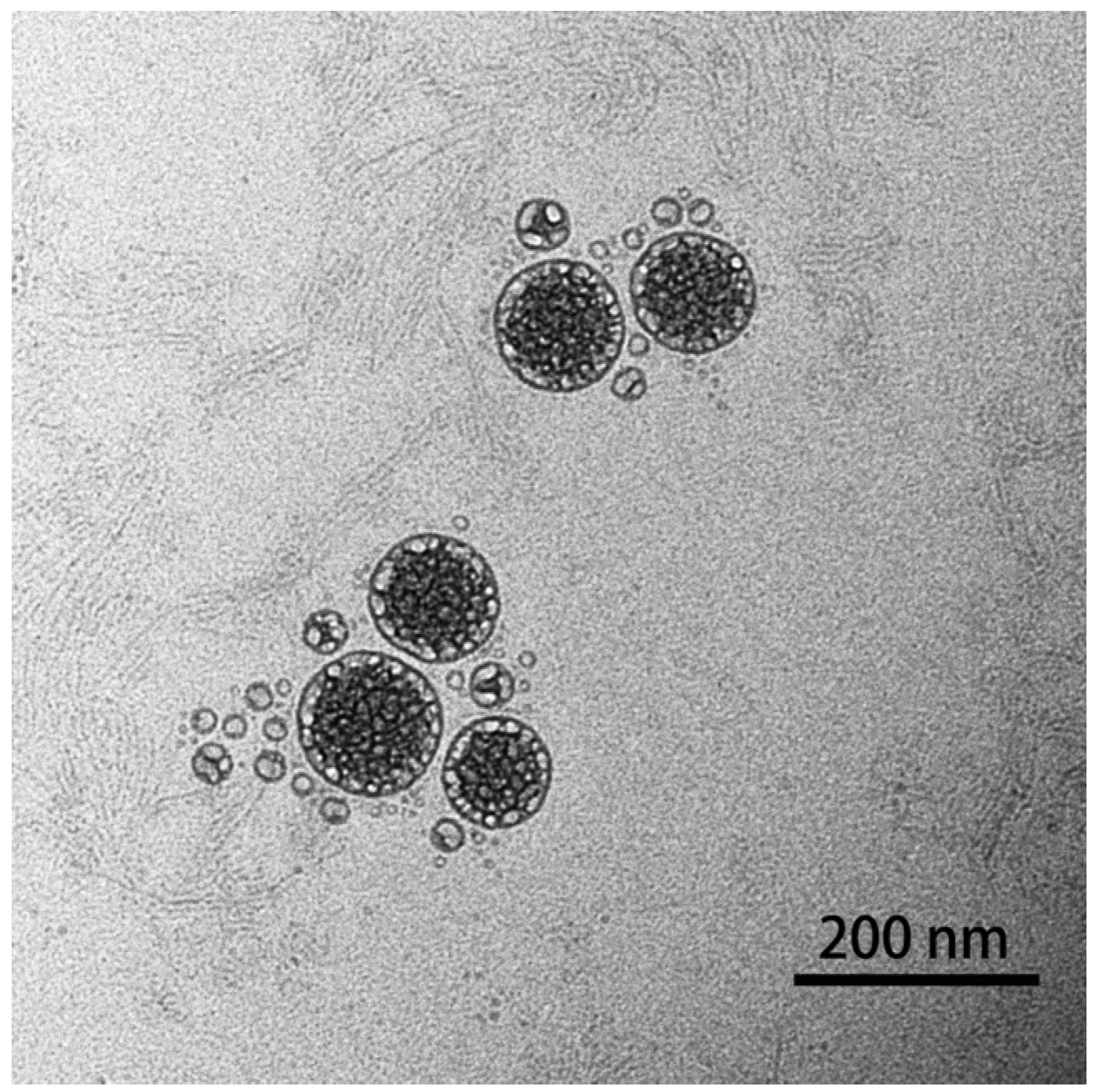
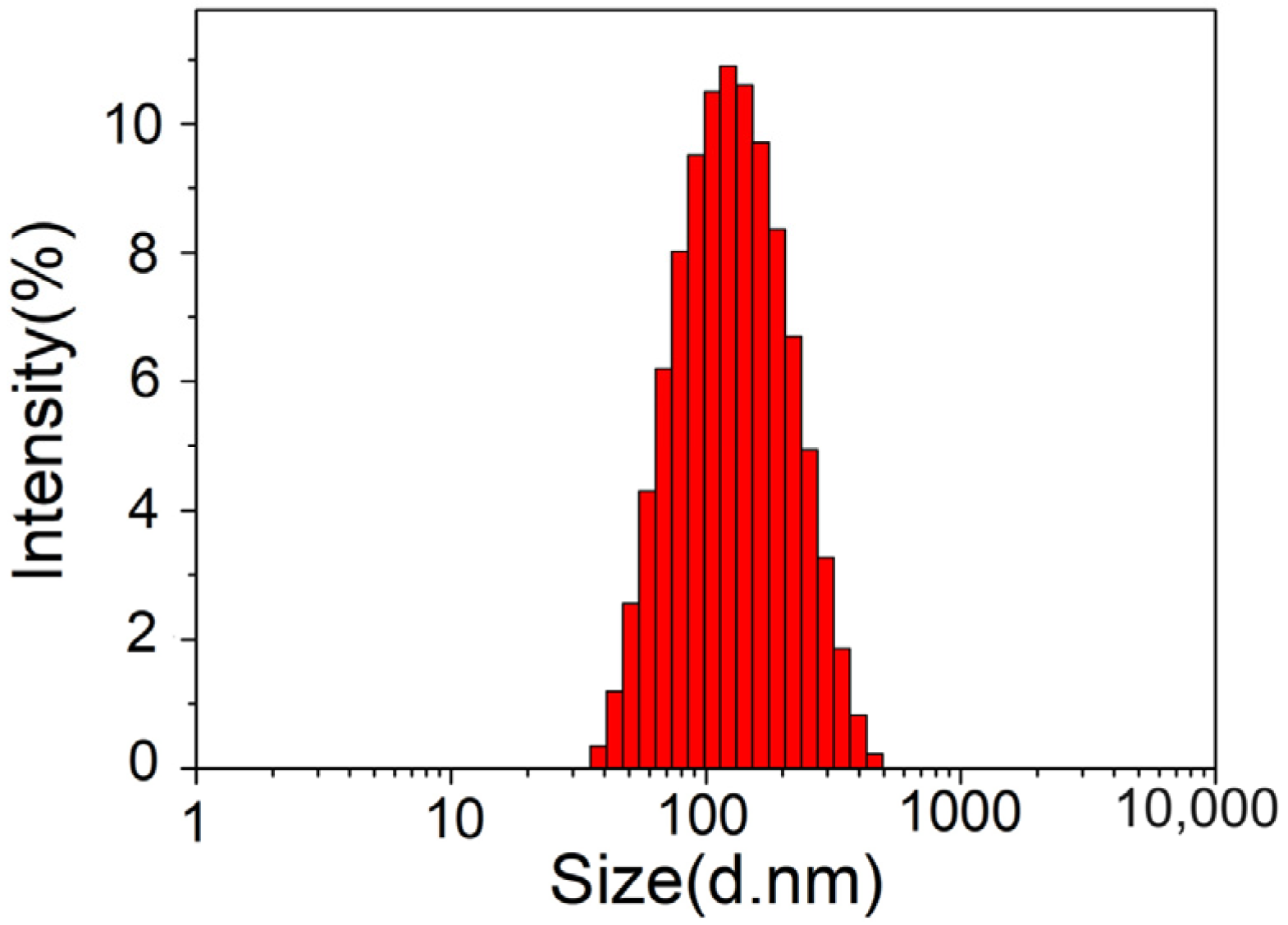
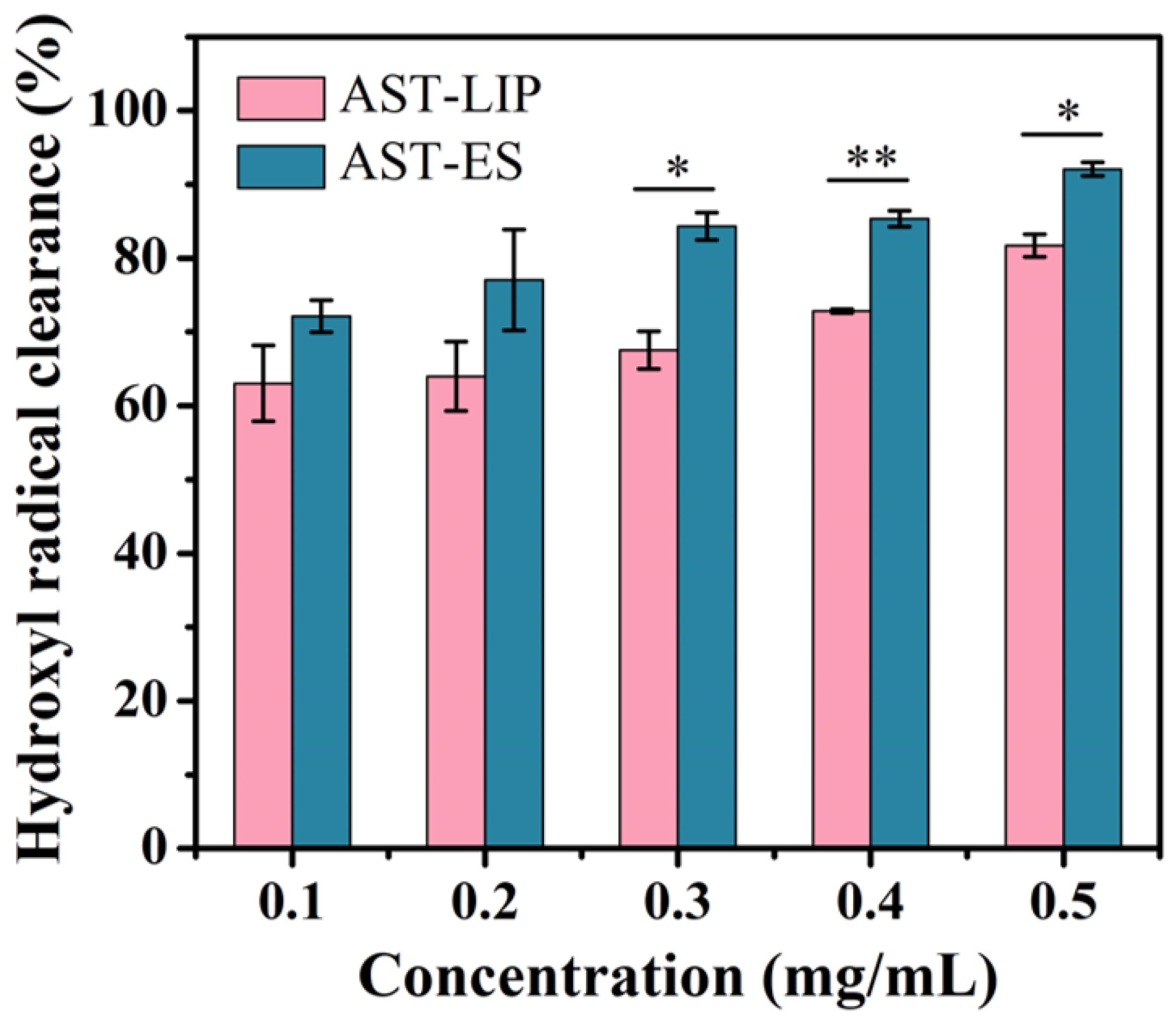
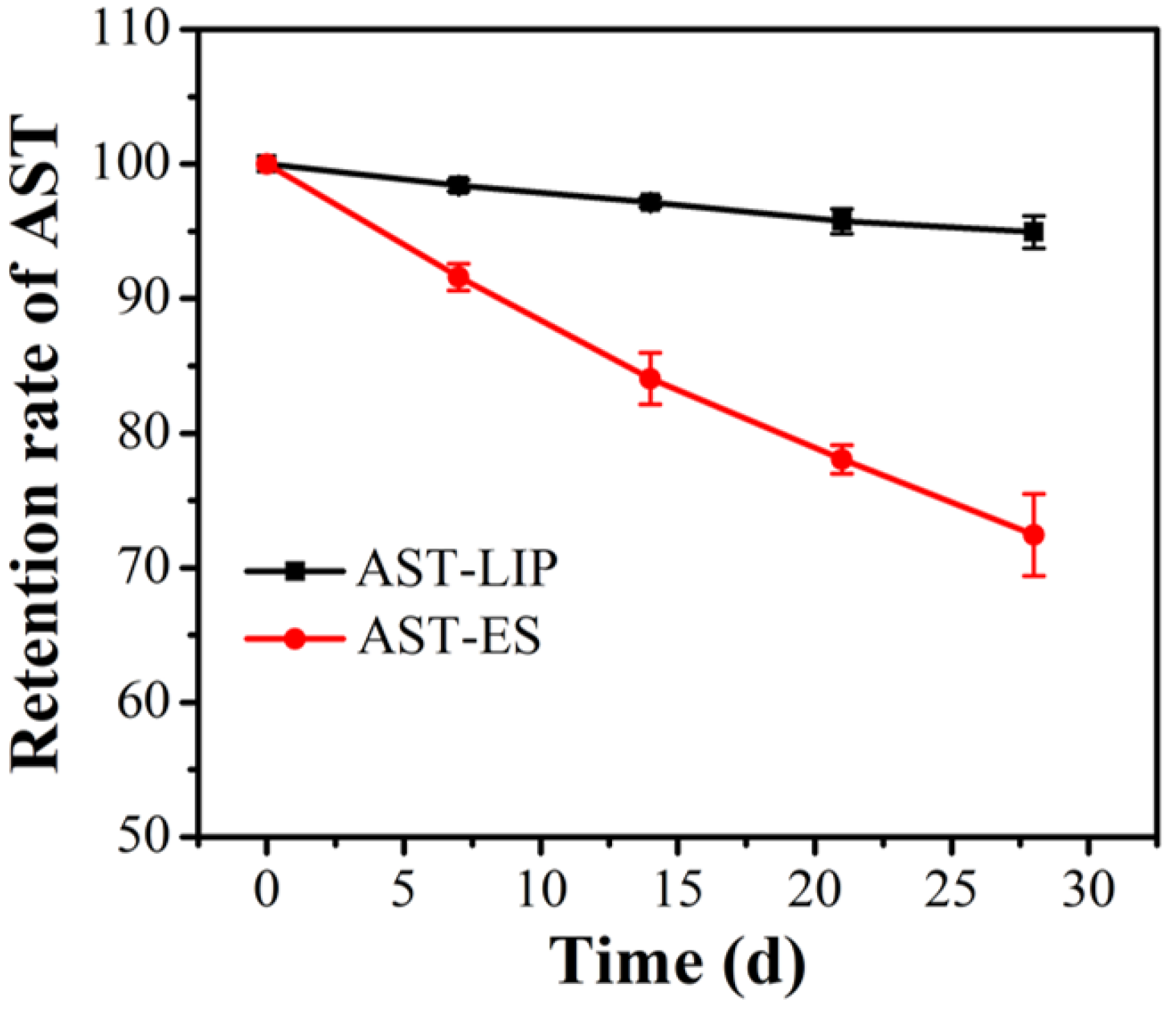
| Test Number | Astaxanthin Input (mg) | EE (%) | LC (%) |
|---|---|---|---|
| 1 | 0.1 | 88.83 | 1.96 |
| 2 | 0.2 | 80.06 | 3.52 |
| 3 | 0.3 | 72.68 | 4.85 |
| 4 | 0.4 | 68.96 | 6.06 |
| 5 | 0.5 | 64.94 | 7.15 |
Disclaimer/Publisher’s Note: The statements, opinions and data contained in all publications are solely those of the individual author(s) and contributor(s) and not of MDPI and/or the editor(s). MDPI and/or the editor(s) disclaim responsibility for any injury to people or property resulting from any ideas, methods, instructions or products referred to in the content. |
© 2024 by the authors. Licensee MDPI, Basel, Switzerland. This article is an open access article distributed under the terms and conditions of the Creative Commons Attribution (CC BY) license (https://creativecommons.org/licenses/by/4.0/).
Share and Cite
Luo, F.; Wang, S.; Zhang, X.; Liu, Z.; Zhu, R.; Xue, W. Extraction of Astaxanthin from Haematococcus pluvialis and Preparation of Astaxanthin Liposomes. Molecules 2024, 29, 3320. https://doi.org/10.3390/molecules29143320
Luo F, Wang S, Zhang X, Liu Z, Zhu R, Xue W. Extraction of Astaxanthin from Haematococcus pluvialis and Preparation of Astaxanthin Liposomes. Molecules. 2024; 29(14):3320. https://doi.org/10.3390/molecules29143320
Chicago/Turabian StyleLuo, Fei, Shuai Wang, Xuwu Zhang, Zhiwei Liu, Ruiyan Zhu, and Weili Xue. 2024. "Extraction of Astaxanthin from Haematococcus pluvialis and Preparation of Astaxanthin Liposomes" Molecules 29, no. 14: 3320. https://doi.org/10.3390/molecules29143320





